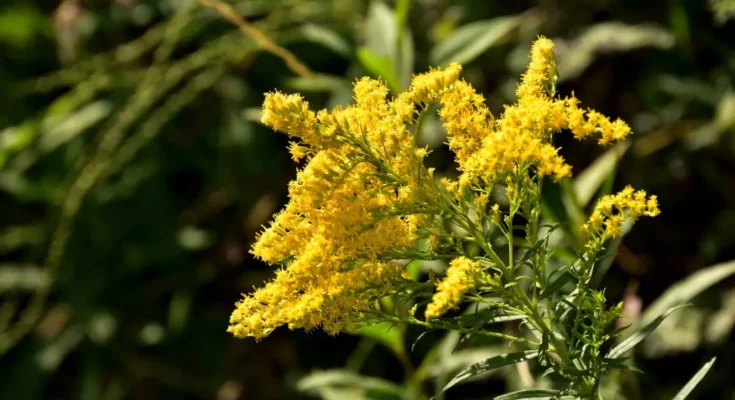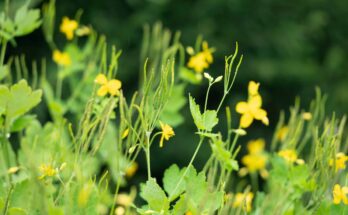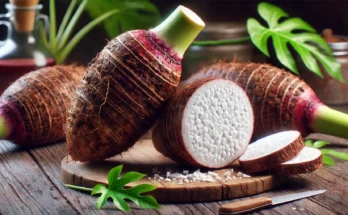Goldenrod (Solidago spp.) is a genus of flowering plants in the Asteraceae family, well-known for its bright yellow flowers that bloom in late summer and early autumn. Often found in fields, meadows, and along roadsides, goldenrod is not just a beautiful wildflower; it has also been prized for its medicinal properties for centuries. While it’s sometimes mistakenly blamed for hay fever, goldenrod offers a wide array of health benefits, thanks to its leaves, flowers, and roots. In this article, we’ll take a closer look at how each part of the goldenrod plant can support well-being.
1. Goldenrod Flowers: A Rich Source of Antioxidants and Anti-Inflammatory Compounds
Goldenrod flowers are the most commonly used part of the plant in herbal medicine. They are packed with bioactive compounds, including flavonoids, phenolic acids, and essential oils, that make them a powerhouse of natural health benefits.
- Antioxidant Properties: Goldenrod flowers are rich in antioxidants, such as quercetin, rutin, and kaempferol, which help protect the body from oxidative stress. Oxidative stress occurs when free radicals damage cells, contributing to the aging process and various chronic diseases like heart disease and cancer. The antioxidants found in goldenrod can help neutralize these free radicals and support overall cellular health.
- Anti-Inflammatory Effects: Goldenrod flowers have been traditionally used to treat inflammatory conditions, including arthritis and urinary tract infections. The flowers’ natural compounds can reduce inflammation in the body, potentially relieving symptoms of chronic conditions like arthritis, muscle pain, and swelling.
- Antimicrobial Action: The flowers are also recognized for their antimicrobial properties. They can be used in herbal teas, tinctures, or topical applications to support the immune system and ward off infections, especially in the urinary tract.
How to Use: The flowers of goldenrod are commonly brewed into a tea, or made into tinctures and extracts. The tea can be consumed to promote general health, while tinctures can be used for more targeted relief from inflammation and infections.
2. Goldenrod Leaves: Detoxification and Urinary Support
Goldenrod leaves are also highly valued for their therapeutic effects, particularly in supporting the body’s detoxification and promoting healthy urinary function.
- Diuretic Benefits: Goldenrod leaves have a natural diuretic effect, meaning they help the body excrete excess water and waste products through urine. This property can be beneficial for conditions like edema (fluid retention), kidney stones, and urinary tract infections (UTIs). By increasing urine output, goldenrod leaves help to flush out toxins and reduce swelling.
- Liver Health and Detoxification: The leaves contain compounds that support liver function and aid in detoxification. The liver plays a crucial role in filtering toxins from the body, and goldenrod leaves may help enhance this process, contributing to better overall health.
- Anti-Inflammatory and Antioxidant Action: Like the flowers, goldenrod leaves contain anti-inflammatory and antioxidant compounds, which can be helpful in managing conditions like gout, arthritis, and other inflammatory disorders.
How to Use: Goldenrod leaves are typically used in teas or capsules. To make a simple leaf tea, steep fresh or dried leaves in hot water for 10 to 15 minutes. For more concentrated effects, goldenrod leaf tinctures can be found at many herbal shops or can be prepared at home.
3. Goldenrod Roots: A Strong Support for Respiratory and Immune Health
While the leaves and flowers get much of the attention, goldenrod roots are also highly prized for their medicinal qualities. The roots contain a variety of bioactive compounds that can support the respiratory system, strengthen the immune response, and promote overall vitality.
- Respiratory Support: Goldenrod root has long been used as a remedy for respiratory ailments. It can help alleviate symptoms of colds, coughs, and bronchitis by promoting expectoration (the process of coughing up mucus) and easing inflammation in the airways. The root’s anti-inflammatory properties help soothe irritated respiratory tissues, making it a natural remedy for asthma and seasonal respiratory issues.
- Immune-Boosting Properties: Goldenrod root contains polysaccharides and other immune-stimulating compounds that help strengthen the body’s immune system. Regular consumption of goldenrod root can help prevent infections, improve immune function, and enhance the body’s ability to fight off pathogens.
- Digestive Health: The root has been used to promote digestive health as well. It can stimulate bile production, improve digestion, and alleviate symptoms of indigestion, bloating, and gas.
How to Use: Goldenrod root is often made into a decoction, where the dried root is simmered in water for an extended period (about 20 minutes) to extract the medicinal properties. Root tinctures are also available, though they are more potent than teas and should be used with care.
4. Goldenrod for Skin Health: A Natural Remedy
In addition to its internal benefits, goldenrod can be beneficial for skin health. The plant contains compounds that can soothe irritated skin, reduce redness, and support the healing of minor wounds and cuts.
- Skin Soothing: Goldenrod flowers and leaves are often used in topical preparations for conditions like eczema, psoriasis, and rashes. The anti-inflammatory properties of goldenrod help calm the skin and reduce itching and irritation.
- Antioxidant Protection: The antioxidants in goldenrod flowers and leaves also benefit the skin by neutralizing free radicals that can lead to premature aging. By protecting skin cells from oxidative damage, goldenrod can help maintain youthful-looking skin.
- Healing Wounds: Goldenrod has been used traditionally as a poultice to promote the healing of minor cuts, scrapes, and bruises. Its antimicrobial properties help protect against infection, while its anti-inflammatory compounds speed up the healing process.
How to Use: Goldenrod-infused oils, creams, and ointments are widely available for topical use. Alternatively, you can make your own skin care remedies by infusing goldenrod flowers or leaves in olive oil or coconut oil and applying the infused oil to irritated skin.
5. Precautions and Considerations
While goldenrod is generally considered safe for most people when used appropriately, there are a few things to keep in mind:
- Allergies: Although goldenrod is often wrongly accused of causing hay fever (due to its bright yellow pollen), it is actually less likely to cause allergic reactions compared to other plants. However, those with sensitivities to plants in the Asteraceae family (such as ragweed, daisies, or marigolds) should exercise caution.
- Pregnancy and Breastfeeding: Pregnant or breastfeeding women should consult a healthcare professional before using goldenrod in medicinal doses, as it can affect uterine contractions or have other unintended effects.
- Kidney Disease: Due to its diuretic properties, individuals with kidney disease or those on medication for kidney conditions should consult with a healthcare provider before using goldenrod.



